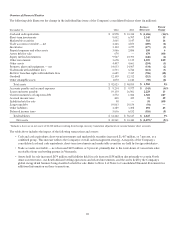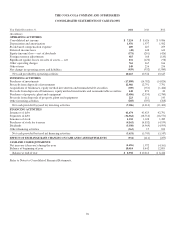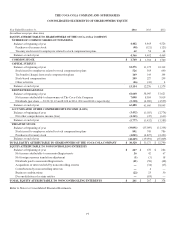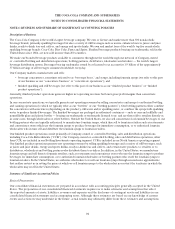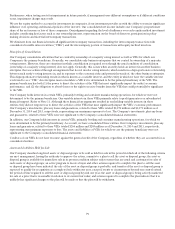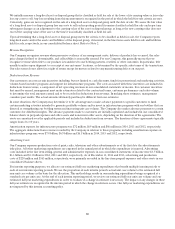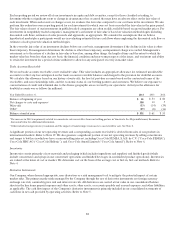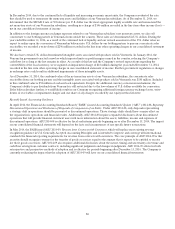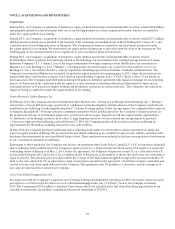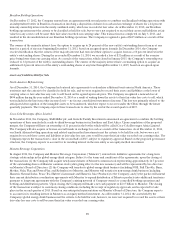Coca Cola 2014 Annual Report Download - page 81
Download and view the complete annual report
Please find page 81 of the 2014 Coca Cola annual report below. You can navigate through the pages in the report by either clicking on the pages listed below, or by using the keyword search tool below to find specific information within the annual report.79
Furthermore, when testing assets for impairment in future periods, if management uses different assumptions or if different conditions
occur, impairment charges may result.
We use the equity method to account for investments in companies, if our investment provides us with the ability to exercise significant
influence over operating and financial policies of the investee. Our consolidated net income includes our Company’s proportionate
share of the net income or loss of these companies. Our judgment regarding the level of influence over each equity method investment
includes considering key factors such as our ownership interest, representation on the board of directors, participation in policy-
making decisions and material intercompany transactions.
We eliminate from our financial results all significant intercompany transactions, including the intercompany transactions with
consolidated variable interest entities (“VIEs”) and the intercompany portion of transactions with equity method investees.
Principles of Consolidation
Our Company consolidates all entities that we control by ownership of a majority voting interest as well as VIEs for which our
Company is the primary beneficiary. Generally, we consolidate only business enterprises that we control by ownership of a majority
voting interest. However, there are situations in which consolidation is required even though the usual condition of consolidation
(ownership of a majority voting interest) does not apply. Generally, this occurs when an entity holds an interest in another business
enterprise that was achieved through arrangements that do not involve voting interests, which results in a disproportionate relationship
between such entity’s voting interests in, and its exposure to the economic risks and potential rewards of, the other business enterprise.
This disproportionate relationship results in what is known as a variable interest, and the entity in which we have the variable interest
is referred to as a “VIE.” An enterprise must consolidate a VIE if it is determined to be the primary beneficiary of the VIE. The
primary beneficiary has both (1) the power to direct the activities of the VIE that most significantly impact the entity’s economic
performance, and (2) the obligation to absorb losses or the right to receive benefits from the VIE that could potentially be significant
to the VIE.
Our Company holds interests in certain VIEs, primarily bottling and container manufacturing operations, for which we were not
determined to be the primary beneficiary. Our variable interests in these VIEs primarily relate to profit guarantees or subordinated
financial support. Refer to Note 11. Although these financial arrangements resulted in our holding variable interests in these
entities, they did not empower us to direct the activities of the VIEs that most significantly impact the VIEs’ economic performance.
Our Company’s investments, plus any loans and guarantees, related to these VIEs totaled $2,274 million and $2,171 million as of
December 31, 2014 and 2013, respectively, representing our maximum exposures to loss. The Company’s investments, plus any loans
and guarantees, related to these VIEs were not significant to the Company’s consolidated financial statements.
In addition, our Company holds interests in certain VIEs, primarily bottling and container manufacturing operations, for which we
were determined to be the primary beneficiary. As a result, we have consolidated these entities. Our Company’s investments, plus any
loans and guarantees, related to these VIEs totaled $266 million and $284 million as of December 31, 2014 and 2013, respectively,
representing our maximum exposures to loss. The assets and liabilities of VIEs for which we are the primary beneficiary were not
significant to the Company’s consolidated financial statements.
Creditors of our VIEs do not have recourse against the general credit of the Company, regardless of whether they are accounted for as
consolidated entities.
Assets and Liabilities Held for Sale
Our Company classifies long-lived assets or disposal groups to be sold as held for sale in the period in which all of the following criteria
are met: management, having the authority to approve the action, commits to a plan to sell the asset or disposal group; the asset or
disposal group is available for immediate sale in its present condition subject only to terms that are usual and customary for sales of
such assets or disposal groups; an active program to locate a buyer and other actions required to complete the plan to sell the asset
or disposal group have been initiated; the sale of the asset or disposal group is probable, and transfer of the asset or disposal group is
expected to qualify for recognition as a completed sale within one year, except if events or circumstances beyond our control extend
the period of time required to sell the asset or disposal group beyond one year; the asset or disposal group is being actively marketed
for sale at a price that is reasonable in relation to its current fair value; and actions required to complete the plan indicate that it is
unlikely that significant changes to the plan will be made or that the plan will be withdrawn.


